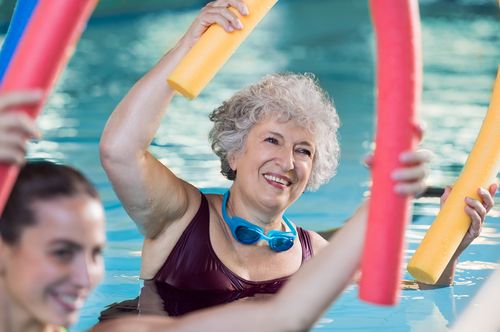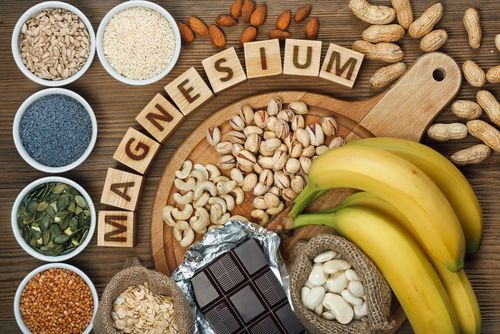Muscle loss as you age is a very real thing. Some of it is just a result of the body getting older, something called sarcopenia. You don't have to just call it quits and accept that you are going to start losing your muscle once you hit your 30s, though. You can arm yourself with knowledge.
Below are a few things that you can do at home to fight muscle loss as you age. All of them are simple and can be done without great expense or inconvenience.
Advertisement
1. Eat protein
As individuals age, their bodies require more protein to maintain their muscle mass. The recommended daily allowance for protein for those older than 64 should be 1.2 g to 1.5 g for every kilogram of body weight. Rather than trying to eat all of the allotment in one sitting, eating it at regular intervals throughout the day will allow for better use and absorption.
As individuals age, their bodies require more protein to maintain their muscle mass. The recommended daily allowance for protein for those older than 64 should be 1.2 g to 1.5 g for every kilogram of body weight. Rather than trying to eat all of the allotment in one sitting, eating it at regular intervals throughout the day will allow for better use and absorption.

Alexander Prokopenko / Shutterstock
2. Aerobic exercise
No matter what your age, exercise is always important. Harvard Medical School says, though, that as you age, it becomes even more important. After the age of 30, people begin to lose muscle much more quickly. Making time for regular aerobic exercise is important. DVDs are plentiful, so find a style you enjoy and make a point to work out three days a week. Stationary bikes, elliptical, treadmills – all of these can be used at home. If you feel like going out, try taking a ballroom dancing class. That will definitely get the heart pumping and work out the muscles at the same time.
No matter what your age, exercise is always important. Harvard Medical School says, though, that as you age, it becomes even more important. After the age of 30, people begin to lose muscle much more quickly. Making time for regular aerobic exercise is important. DVDs are plentiful, so find a style you enjoy and make a point to work out three days a week. Stationary bikes, elliptical, treadmills – all of these can be used at home. If you feel like going out, try taking a ballroom dancing class. That will definitely get the heart pumping and work out the muscles at the same time.

Rido / Shutterstock
3. Resistance training
Berkeley Wellness shares that resistance training (not to be confused with aerobic exercise) should also be done. If using a weight set scares you, try lifting soup cans or partially filled milk bottles at home. Bungee cords make effective resistant cords for legs. A plethora of exercises can be found online that can be done at home.
Berkeley Wellness shares that resistance training (not to be confused with aerobic exercise) should also be done. If using a weight set scares you, try lifting soup cans or partially filled milk bottles at home. Bungee cords make effective resistant cords for legs. A plethora of exercises can be found online that can be done at home.

piksel / Shutterstock
4. Vitamin D
Prevention shares that vitamin D consumption is critical for muscle retention. Taking supplements can be dangerous and not always beneficial. The best way to get vitamins is always through your diet, so try eating some of these vitamin D-rich foods: wild salmon, beef liver, egg yolks, canned fish or shiitake mushrooms.
Prevention shares that vitamin D consumption is critical for muscle retention. Taking supplements can be dangerous and not always beneficial. The best way to get vitamins is always through your diet, so try eating some of these vitamin D-rich foods: wild salmon, beef liver, egg yolks, canned fish or shiitake mushrooms.

Evan Lorne / Shutterstock
5. Get a good night's rest
After a good workout and exercise, it's important to rest, so your muscles have time to recover. It's recommended that each adult get 7 to 9 hours of sleep a night.
After a good workout and exercise, it's important to rest, so your muscles have time to recover. It's recommended that each adult get 7 to 9 hours of sleep a night.

fizkes / Shutterstock
6. Magnesium
The Mayo Clinic notes that having enough magnesium in your diet is also critical for maintaining muscle mass. Some foods listed by the Cedars-Sinai Medical Center that are rich in magnesium include nuts, spinach, milk, bananas and dark chocolate.
The Mayo Clinic notes that having enough magnesium in your diet is also critical for maintaining muscle mass. Some foods listed by the Cedars-Sinai Medical Center that are rich in magnesium include nuts, spinach, milk, bananas and dark chocolate.

Evan Lorne / Shutterstock
7. Refrain from excessive alcohol consumption
Drink in moderation only as alcohol can cause dehydration, impacting muscle function. Mayo Clinic recommends up to 1 drink per day for women of all ages and men older than 65 and 2 drinks per day for men younger than 65.
Drink in moderation only as alcohol can cause dehydration, impacting muscle function. Mayo Clinic recommends up to 1 drink per day for women of all ages and men older than 65 and 2 drinks per day for men younger than 65.

Rustle / Shutterstock
8. Don't forget about the carbs
Carbs are vital to helping build muscle before or after a workout. For a healthy diet, stick to whole grains, but it's important not to skip carbs when aiming to build muscle.
Carbs are vital to helping build muscle before or after a workout. For a healthy diet, stick to whole grains, but it's important not to skip carbs when aiming to build muscle.
Advertisement

Shutterstock

